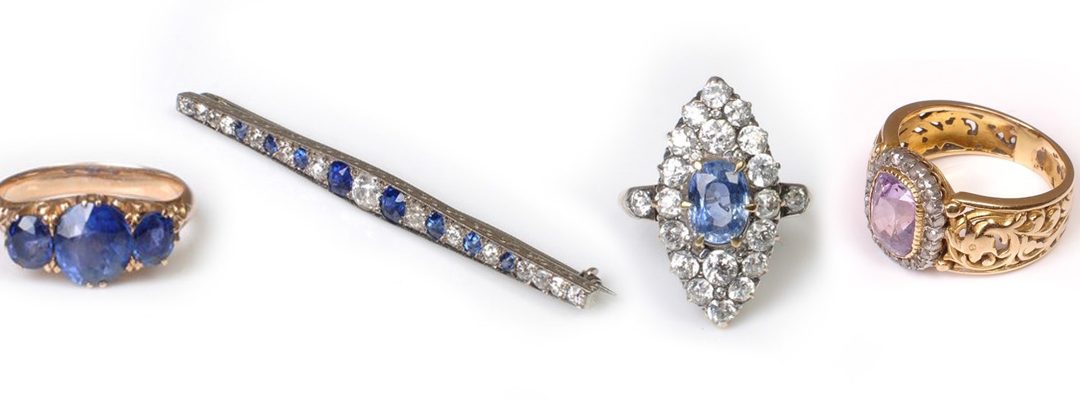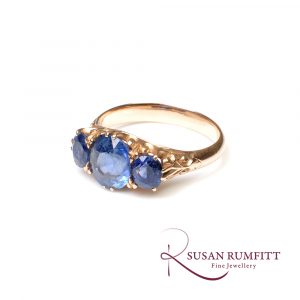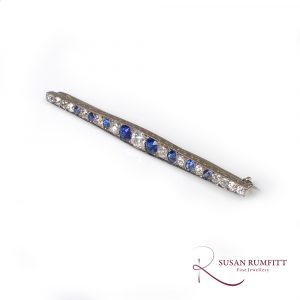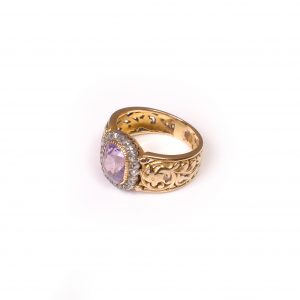Sapphire is September’s birthstone and is the first focus of our new series of blogs looking at the birthstones for each month of the year.
Despite its most common incarnation as a blue stone, sapphire can actually be found in a variety of colours – except for red. That’s because a red sapphire is called a ruby.
Sapphire is the birthstone for September and therefore includes the Virgo and Libra zodiac signs. It is believed to attract blessings and abundance, and to help calm the mind, heal the body and give clarity to the spirit. In its blue form, sapphire symbolises integrity, truth and wisdom.
Sapphire is often associated with royalty and romance, and is a popular choice for engagement rings. Blue sapphire is also given as a gift for 5th and 45th wedding anniversaries.
Sapphire gemmology
Sapphire is the common name for the mineral corundum. Corundum is 9 on the Moh’s scale of hardness, second only to diamond. Its great hardness has led to its use in a large variety of industrial settings; from creating the grit on your nail file to cutting all other gemstones except diamond.
Lustre is light reflecting off the surface of a gemstone. As a general rule the harder a gemstone the more light it will reflect, and the better it will hold a polish which also helps light reflection. So, sapphire’s high hardness helps it to reflect light off its surface and twinkle as you move.
It’s also very tough, having no natural cleavage, and is very resistant to chemical or heat attack, making it not only a gemstone that’s beautiful to wear but one that’s very good for everyday wear. These properties also mean that it is routinely treated to enhance the colour.
Sapphire crystals form in magmatic rock. As the rock cools, aluminium and oxygen atoms bond in a hexagonal pattern, forming a hexagonal bi-pyramidal crystal. Many of the inclusions follow this pattern within the sapphires. Colour zoning is the lack of uniform colour through the stone, and is often seen in sapphires following the hexagonal crystal form.
“Silk” are very fine rutile needle inclusions which form in the hexagonal crystal. Very fine silk can cause a velvety appearance in fine Kashmir sapphires. Profuse silk can cause asterism (a star of light effect).
Blue sapphire and other colours
In its pure form sapphire is colourless and any colour it develops is dependent on minor amounts of metal oxide impurities within the crystal structure. For example, blue sapphire is coloured by iron and titanium, whereas yellow is iron alone, and orange is iron and chromium. Corundum with chromium as a trace element creates rubies as the colour that forms is red.
It’s commonly accepted that if you say “sapphire” you are referring to a blue sapphire, as historically this has been the most highly prized. All other sapphires are referred to as “fancy” sapphires and have the colour as their prefix; pink sapphire, yellow sapphire etc. Blue sapphires, as the more sought-after variety, tend to command higher prices than the fancy colours.
Excepting ruby, there are a couple of other varieties of sapphire that can out-perform blue sapphire in the price per carat stakes.
Padparascha is the pinky-orange or orangey-pink variety of sapphire featured in Princess Eugenie’s engagement ring in 2018. Traditionally found in Sri Lanka it was described as halfway between the colour of a lotus and a sunset.
Star sapphires, as the name suggest, have a star of light which appears to hover on the surface of the stone. This effect, known as asterism, is caused by light reflecting off many fine, thin, parallel, needle-like inclusions, formed in alignment with the hexagonal crystal structure crossing over at 60 degrees and forming a star.
Famous Sapphires
A world-famous star sapphire is The Star of Asia, which is on display at the Smithsonian. At 329 carats The Star of Asia is not the biggest star sapphire, however – that title is currently held by The Star of Adam at a whopping 1,404 carats. However, The Star of Asia has a more intense blue colour than The Star of Adam, with a sharper central star, making it one of the world’s finest star sapphires.
Queen Marie of Romania’s Sapphire
At 478 carats, Queen Marie of Romania’s Sapphire is the largest faceted sapphire known to date. Originating from Sri Lanka (Ceylon), as all of the world’s biggest sapphires do, it was exhibited by Cartier in 1919 at San Sebastian, Spain. Here it caught the eye of Queen Ena of Spain who tried it on, but King Alfonso failed to buy it for her. Instead, it was bought by King Ferdinand of Romania for his glamourous wife Queen Marie who had lost many of her jewels during the Russian war. By the end of the Second World War the Romanian royal family were forced to abdicate, and the sapphire was sold to Harry Winston. He then sold it to a wealthy Greek citizen, who presented it to the Greek queen consort, Friederika. In 1970 the Greek monarchy was abolished and the sapphire was lost from sight, only to pop up again in a 2003 Christie’s sale, when it sold for $1.4 million. Although purchased by a private buyer it has been seen in exhibitions since.
The Richelieu Sapphires
Whilst the biggest sapphires originate in Sri Lanka, the most highly prized sapphires hail from the now exhausted Kashmir mines. Sapphires from Kashmir are often referred to as cornflower blue with a slightly more violet tone than other sapphires. They can also contain very fine rutile silk inclusions which create a soft, sleepy or velvety appearance that adds to their beauty and makes them some of the most expensive gems in the world.
Odile de Richelieu, Countess Gabriel de La Rochefoucauld, Princess de La Rochefoucauld was given a fabulous pair of matching Kashmir sapphires by her husband on her wedding day in 1905. They became the most expensive coloured gemstone earrings when they sold at Sotheby’s for £5.2 million in 2013
Sapphires at Susan Rumfitt Fine Jewellery
Of course, at Susan Rumfitt’s gallery in Harrogate we have a lovely selection of new, vintage and antique pieces. Here are some of our favourites:
Pictured from left are:
- A charming Victorian sapphire three stone ring. Beautiful graduated Sri Lankan sapphires sit in a gallery carved with fleur-de-lis and scroll motifs.
- A classic Art Deco sapphire and diamond brooch. Graduated sapphire and diamond are set within an elegantly engraved gallery.
- Gorgeous antique Sri Lankan sapphire and old cut diamond navette ring. Sits low to the finger so it’s very comfortable to wear while still maintaining a big look.
- Pretty antique pink sapphire and diamond ring. Sapphire is a very delicate shade of pink within a delicate border of rose cut diamonds, and ornately pierced shoulders finish this attractive ring.
Click here to browse our full collection of sapphire jewellery or book an appointment for a private viewing of The Gallery Collection.




